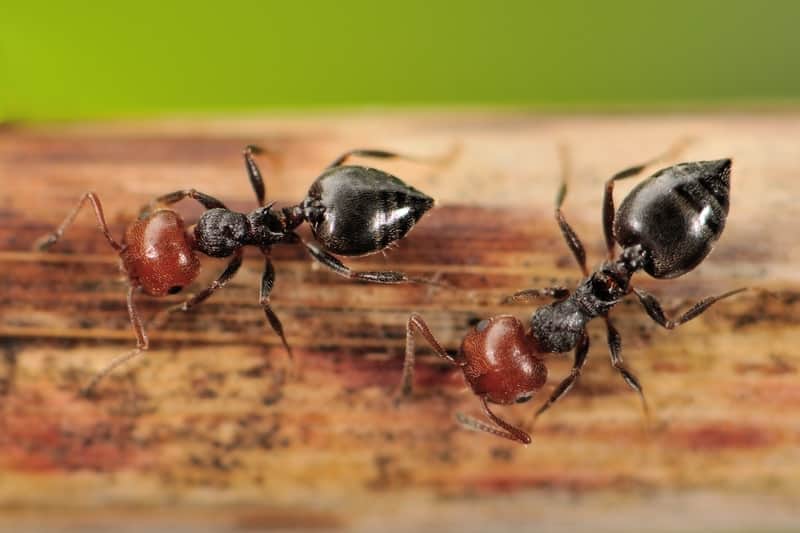Carpenter ants aren’t the only ants that live in wood. Acrobat ants also like to nest in moist and rotting wood, among other places. Learn the signs of acrobat ants in your home, where they’re likely to nest and the ways you can help treat and get rid of them.

What Are Acrobat Ants?
Acrobat ants get their name from the behavior they exhibit when excited or disturbed. Agitated worker ants lift their tail ends above the rest of their body, almost as if they were doing a balancing act.
Acrobat ants are light brown to black in color, although they can also be a combination of brown, black and red. They are relatively small, measuring up to one-sixteenth of an inch long. When viewed from above, their abdomen appears heart-shaped.
Common Habitats of Acrobat Ants
Outdoors, most species of acrobat ants nest under rocks and in decayed portions of logs, stumps, fences, decks, railings, firewood and trees. They also build their nests in abandoned cavities carved out by other insects, such as termites and carpenter ants.
While foraging for both food, like sweets and meats, and potential nesting places, worker acrobat ants can also find their way inside homes by following tree limbs and entering through cracks or holes around door frames, windows and other entry points. They can also enter through the same structural openings that allow wires and pipes to pass through your house. Once inside, acrobat ants may nest in wall voids, foam insulating boards, sheathing or wood that has been compromised by water damage, mold or mildew.
Acrobat ants are more of a nuisance than a source of destruction when they’re in your home. Unlike carpenter ants, who can cause severe structural damage, acrobat ants are not known for causing damage to wood as they infest wood that has already been damaged. However, they can pose a risk by stripping insulation from electrical and telephone wires, which can cause short circuits. They also have the ability to sting, which they may do if they feel threatened.
Signs of an Acrobat Ant Infestation
Small piles of sawdust are the most common sign that acrobat ants may have invaded your home. This sawdust is produced by the ants excavating their nesting sites. But this could also be a sign of other insect infestations.
Additionally, like other ants, acrobat ant colonies may produce winged, reproductive males and females called swarmers. When the conditions are right, these mature acrobat ants will emerge from an established colony, then disperse, mate and create new colonies. These conditions include sun, warm temperatures and high humidity. The swarmers are generally harmless, but they are likely an indication that you have an acrobat ant infestation on or around your property. Since the ants lose their wings after mating, these discarded wings are a sign of a potential ant infestation.
Acrobat Ant Prevention and Treatment
There are various ways to help prevent and treat an acrobat ant infestation, beginning with performing basic preventive maintenance around your home's exterior:
- Begin with a thorough inspection. Look for any likely entry points and caulk or otherwise seal them. Pay special attention to potential problem areas around your doors, windows, pipes and utility lines. Have a professional inspect areas of your home that aren't visible from the ground.
- Eliminate sources of standing water, and divert water away from your home’s foundation with properly functioning gutters, downspouts and splash blocks.
- Have all tree branches trimmed and shrubbery moved away from your home's roof, foundation, siding and exterior walls.
- Store firewood in a rack or other container that keeps the wood from touching the ground. Place firewood at least 20 feet away from your home.
Inside your home, take the following steps:
- Keep your house clean. Acrobat ants need both sugar and protein in their diets. Clean up all spills quickly and keep all food in airtight containers.
- Look for plumbing leaks. Repair them quickly, and replace any water-damaged materials, especially wood.
- Pay close attention to humidity levels in your home, especially in your bathroom and kitchen. Eliminate damp spots and watch for the signs of rotting or decaying wood.
If you are currently trying to cope with acrobat ants or want to help stop them from getting into your home in the first place, contact the professionals at Terminix®. Our trained pest control professionals know what it takes to effectively remove ants from your property.




